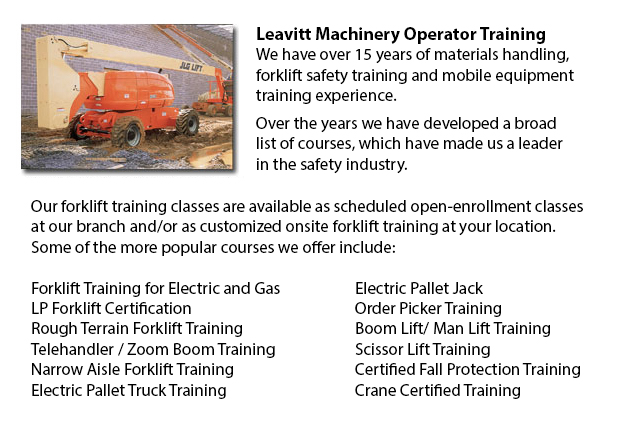
Aerial Lift Safety Training Oakville - There are around 26 to 30 construction fatalities within North America due to the utilization of aerial lifts. Nearly all of the individuals killed are craftsmen like laborers, painters, electrical workers, ironworkers or carpenters. Most deaths are caused by falls, tip-overs and electrocutions. The greatest risk is from boom-supported lifts, like cherry pickers and bucket trucks. Nearly all fatalities are related to this particular type of lift, with the rest involving scissor lifts. Other dangers consist of being struck by falling things, being thrown out of a bucket, and being caught between the guardrail or lift bucket and an object, like for instance a steel beam or joist.
The safe operation of an aerial lift requires an inspection on the following things before utilizing the device: operating and emergency controls, personal fall protection gear, safety devices, and tires and wheels. Check for possible leaks in the air, fuel-system, hydraulic fluid. Check the device for missing or loose parts.
The areas where worker would make use of the aerial device must be examined carefully for possible hazards, like for example holes, bumps, debris and drop-offs. Overhead powerlines need to be monitored and avoided. It is recommended that aerial lift devices be utilized on surfaces which are level and stable. Don't work on steep slopes that exceed slope limitations specified by the manufacturer. Even on a level slope, brakes, wheel chocks and outriggers should be set.
Companies should provide their aerial lift operators with the correct instruction manuals. Mechanics and operators should be trained by a licensed person experienced with the relevant type of aerial lift.
Aerial Lift Safety Tips:
o Close lift platform chains or doors prior to operating.
o Climbing on and leaning over guardrails is prohibited. Stand on the platform or floor of the bucket.
o Use the provided manufacturer's load-capacity restrictions.
o Utilize work-zone warnings, like for instance cones and signs, when working near traffic.
If correct procedures are followed, electrocutions are preventable. Stay at least 10 feet away from whatever power lines and certified electricians should de-energize and/or insulate power lines. Those working need to make use of personal protective equipment and tools, such as a bucket that is insulated. However, an insulated bucket does not protect from electrocution if, for example, the individual working touches a different wire providing a path to the ground.
When within the bucket, workers should prevent possible falls by securing themselves to the guardrails by utilizing a positioning device or a full-body harness. If there is an anchorage in the bucket, a positioning belt with a short lanyard is adequate.
By following the manufacturer's instructions, tip-overs could be prevented. Never drive the lift platform when it is elevated, unless otherwise specified by the manufacturer. Follow the device's horizontal and vertical reach restrictions, and never go beyond the load-capacity which is specified.
-
Order Picker License Oakville
Order Picker License Oakville - Order preparation operation or order picking as it is more normally known is a method used within warehouse operations and consists of employees called order pickers. The order picker's task is to collect and take arti... More -
Forklift Operator Certification Oakville
Forklift Operator Certification Oakville - Forklift operator certification is normally needed for personnel working within industrial, warehouse or construction setting to guarantee the safe utilization of forklifts. Workplace training need to follow... More -
Scissor Lift Certification Oakville
Scissor Lift Certification Oakville - A lot of worksites and tradespeople like iron workers, welders and masons utilize scissor lift platforms to help them reach elevated work areas. The utilization of a scissor lift is usually secondary to their tra... More -
Forklift Training Courses Oakville
Forklift Training Courses Oakville - When forklift operator safety training is customized for illiteracy, training time is reduced by 50%. Train the trainer, forklift training certification and lift-truck operator driver safety training evaluation pr... More -
Manlift Training Oakville
Manlift Training Oakville - There are numerous manlift training programs which offer a review of the manlift machinery. The practicum portion of the training is one more vital portion of the course. In this section the trainee has chance to demonstra... More -
Boom Lift License Oakville
Boom Lift License Oakville - To operate an aerial boom lift, operators should be licensed through training that can be obtained utilizing both classroom sessions and practical training and by attaining a boom lift license. Instruction should be given... More -
Crane / Overhead Crane / Self-Erect Crane / Truck Mounted Crane / Hydraulic Cranes Training in Oakville
Bridge cranes or likewise called overhead cranes are actually a type of industrial material handling crane using a line and hook mechanism that runs on a horizontal beam running along two widely separated rails. Several overhead cranes could be seen... More -
Telehandler Training in Oakville
Telescopic handlers normally called telehandlers for short, are an extremely popular piece of heavy construction machinery. They are widely utilized in the construction and agricultural trades. These machines have maximum reaching ability and could g... More

Forklift Training Oakville
TOLL FREE: 1-888-254-6157
Oakville, Ontario
forklifttrainingoakville.com
Email Us
About Us


